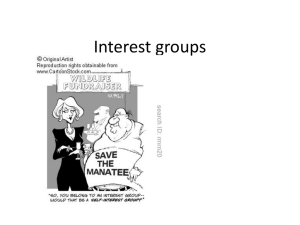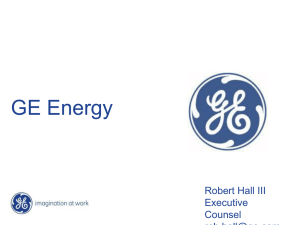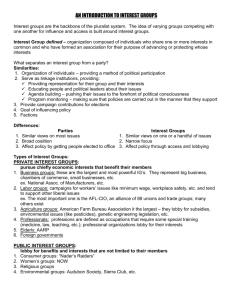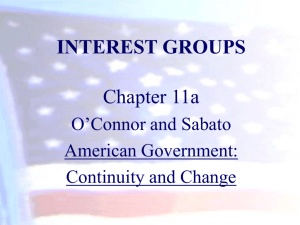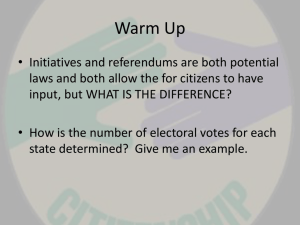Delaware Recommended Curriculum Teaching Civics with Primary Sources Grant Project
advertisement
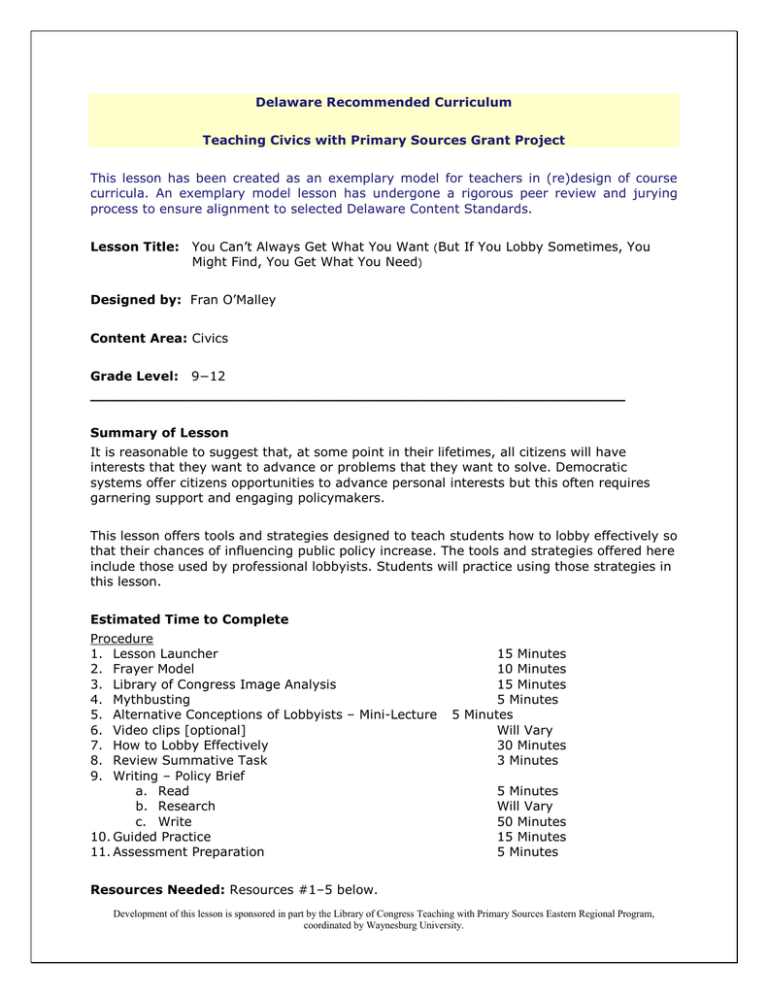
Delaware Recommended Curriculum Teaching Civics with Primary Sources Grant Project This lesson has been created as an exemplary model for teachers in (re)design of course curricula. An exemplary model lesson has undergone a rigorous peer review and jurying process to ensure alignment to selected Delaware Content Standards. Lesson Title: You Can’t Always Get What You Want (But If You Lobby Sometimes, You Might Find, You Get What You Need) Designed by: Fran O’Malley Content Area: Civics Grade Level: 9−12 ____________________________________________________________ Summary of Lesson It is reasonable to suggest that, at some point in their lifetimes, all citizens will have interests that they want to advance or problems that they want to solve. Democratic systems offer citizens opportunities to advance personal interests but this often requires garnering support and engaging policymakers. This lesson offers tools and strategies designed to teach students how to lobby effectively so that their chances of influencing public policy increase. The tools and strategies offered here include those used by professional lobbyists. Students will practice using those strategies in this lesson. Estimated Time to Complete Procedure 1. Lesson Launcher 2. Frayer Model 3. Library of Congress Image Analysis 4. Mythbusting 5. Alternative Conceptions of Lobbyists – Mini-Lecture 6. Video clips [optional] 7. How to Lobby Effectively 8. Review Summative Task 9. Writing – Policy Brief a. Read b. Research c. Write 10. Guided Practice 11. Assessment Preparation 15 Minutes 10 Minutes 15 Minutes 5 Minutes 5 Minutes Will Vary 30 Minutes 3 Minutes 5 Minutes Will Vary 50 Minutes 15 Minutes 5 Minutes Resources Needed: Resources #1–5 below. Development of this lesson is sponsored in part by the Library of Congress Teaching with Primary Sources Eastern Regional Program, coordinated by Waynesburg University. Tips for the Teacher I. Coordinate with DRC Project Citizen Unit: This lesson can also be taught as part of the Delaware Recommended Curriculum’s Grade 9–12 Project Citizen unit (access at http://www.doe.k12.de.us/infosuites/staff/ci/content_areas/social_studies/pilot_912.shtml). There are several points in the unit where it might be incorporated or replace an existing procedure including: a. Substitute this lesson for Lesson 2, Strategy 2 as all of the methods of influencing government bureaucracies listed in Strategy 2 will involve lobbying in some form. b. Integrate this lesson into Lesson 2, Strategy 3: Writing an Action Plan where students are asked “what methods of persuasion will you use?” c. Teach this lesson just before the students present to the simulated public hearing that is described in Lesson 3, Strategy 5. II. Interdisciplinary Collaboration: This lesson offers civics teachers an excellent opportunity to work collaboratively with ELA teachers. ELA teachers can offer additional guidance on writing and speaking persuasively. Development of this lesson is sponsored in part by the Library of Congress Teaching with Primary Sources Eastern Regional Program, coordinated by Waynesburg University. Stage 1 – Desired Results What students will know, do, and understand. ____________________________________________________________ Delaware Content Standard Addressed: Civics Standard Four 9-12a: Students will develop and employ the skills necessary to work with government programs and agencies. Big Ideas Lobbying and communicating effectively. Unit Enduring Understanding Understanding and applying professional lobbying strategies improve a citizen’s ability to influence policy, advance interests, and solve problems. Lesson Essential Question How can I lobby effectively to shape public policy? Problematic Prior Learning (or common misconceptions) All lobbyists are crooks. All lobbyists work for bad causes. Lobbyists work for others, not for me. Lobbying only involves trying to persuade policymakers to do something (it also involves trying to persuade policymakers NOT to do something). Knowledge and Skills Students will know… Roles that lobbyists play in a democratic society. Strategies recommended by lobbyists. Lobbying helps all citizens shape private and public policy. Citizens can use the strategies employed by lobbyists to advance their own public policy goals. Academic vocabulary including: o Lobby – (1) To try to get something you want by talking to the people who make decisions; (2) the act of attempting to influence business and government leaders to create legislation or conduct an activity that will help a particular organization; (3) an organized group of people who work together to influence government decisions that relate to a particular industry, issue, etc. o Lobbyist - Is a person whose job it is to convince legislators or other policymakers to vote a certain way. Students will be able to… Describe lobbying strategies. Apply strategies recommended by lobbyists. Development of this lesson is sponsored in part by the Library of Congress Teaching with Primary Sources Eastern Regional Program, coordinated by Waynesburg University. Stage 2 – Assessment Evidence Evidence that will be collected to determine whether or not Desired Results are achieved. ___________________________________________________________________ Assessment Recommendations to Teachers: Coordinate this assessment with the principal and other teachers in your building. Coordination might include (1) informing them of the task and its timeframe, (2) recruiting staff to participate in the activity, (3) creating a list of teachers or staff who are willing to participate in the activity, (4) providing participating staff with a description of the task and the assessment’s scoring rubric, and (5) perhaps providing volunteers with the name(s) of students who may be contacting them to schedule a “lobbying” session. If you implement this lesson before doing Project Citizen, the task you assess with the rubric provided below can be linked to lobbying that students do as part of their Project Citizen Action Plan. Essential Questions Measured by the Assessment Task: How can I lobby effectively to shape public policy? Prior Knowledge Recall the strategies that you read about in the Democracy Project’s Lobbyist’s Playbook then applied in the activities featured in this lesson. Problem Students often have great ideas for improving school policies but, for a variety of reasons, rarely take effective steps to have them put into action. Traditional reasons include the facts that most students have not been taught how to lobby effectively and have not been given sufficient opportunities to apply effective lobbying strategies in authentic situations. Role/ As a class, you are to come up with one idea for improving your school. Then, each of you is to lobby to have your class idea adopted (or not). Some of you may not agree with the class idea and that is fine. If you do not support the idea, your task will be to lobby to prevent the idea from being adopted. To summarize, you will be lobbying at least one teacher in your building to support or oppose the class idea for school improvement. Perspective Product/ Performance Your teacher will assign you to one teacher within your school whom you are to lobby. Only lobby those to whom you are assigned (or the other teachers may get annoyed!). Schedule a meeting with the teacher to whom you are assigned. Prepare a policy brief that you can share with your assigned teacher. Prepare and deliver a brief presentation in which you use strategies from this lesson’s Lobbyist’s Playbook to convince a teacher to support or oppose the class policy. Follow-up your meeting with the teacher to see how well you lobbied, how you might improve next time, and whether they decided to support or oppose the class policy and why. Development of this lesson is sponsored in part by the Library of Congress Teaching with Primary Sources Eastern Regional Program, coordinated by Waynesburg University. Criteria for an Exemplary Response (see rubric below) Well-developed written policy brief. Well-executed oral presentation and discussion. Effective use of lobbying strategies. Deep understanding of the issue (arguments for and against). Post Assessment Reflection: Engage the students in a discussion of their lobbying experiences. Suggested questions include: What went well? What might they do differently next time? Do the same lobbying strategies work with everyone or does a lobbyist have to adapt his or her strategies to the situation and person being lobbied? Have their perceptions of lobbyists or lobbying changed as a result of the experience? How and why? Do you see yourself using any of these strategies down the road? Elaborate. Development of this lesson is sponsored in part by the Library of Congress Teaching with Primary Sources Eastern Regional Program, coordinated by Waynesburg University. Rubric 1 Below Standard Strategies Written Communication Speaking Listening Few of the recommended lobbying strategies are employed in ways that are largely ineffective Policy brief… Introduces and develops a claim. Supplies little evidence for that claim. Presents shortcomings of current policy. Offers recommendations. Is not persuasive. Contains numerous mechanical errors. Student comes to the discussion showing little evidence of preparation, fumbles through the discussion, and is largely unconvincing. Student dominates the discussion in defense of one position and overlooks or talks past opportunities to consider alternative perspectives. 2 Approaches Standard 3 Meets Standard Recommended lobbying strategies are employed effectively throughout the process. Recommended lobbying strategies are employed and adapted skillfully to the circumstances that arise during the process. Policy brief… Introduces and develops a claim concisely. Supplies compelling evidence for that claim with citations. Presents significant shortcomings of current policy. Offers reasonable recommendations that flow logically from the claim and evidence. Is highly persuasive. May have 1-2 mechanical errors that do not distract from the substance of the text. Student comes to the discussion prepared to discuss claims and counterclaims, having read and researched information about the policy, and explicitly draws on that preparation by referring to evidence from texts and other research relating to the policy to stimulate a thoughtful, well-reasoned exchange of ideas. Student considers, appreciates, and responds thoughtfully to alternative perspectives and, when warranted, qualifies or justifies his or her own views and understanding. Policy brief… Introduces and develops a claim concisely. Supplies some evidence for that claim. Presents shortcomings of current policy. Offers recommendations grounded partially in the evidence. Is somewhat persuasive. Contains few mechanical errors. Student comes to the discussion prepared, having read and researched information about the policy, and draws on that preparation to argue for a position. Student responds to alternative perspectives but fails, when warranted, to qualify or justify his or her own views and understanding. This rubric attends to grades 9-12 ELA Common Core standards assuming that the civics course and lesson are being taught in grade 9. Development of this lesson is sponsored in part by the Library of Congress Teaching with Primary Sources Eastern Regional Program, coordinated by Waynesburg University. Stage 3 – Learning Plan Design learning activities to align with Stage 1 and Stage 2 expectations. ___________________________________________________________________ Essential Question How can I lobby effectively? Instructional Strategies 1. Lesson Launcher: Activating Schema a. Play the Rolling Stones song You Can’t Always Get What You Want in the background as students enter class. Project the following lines from the chorus on the board: ♪ “You can’t always get what you want But if you try sometimes, you might find You get what you need.” ♪ [You may ask students if they have heard this Rolling Stones song from 1969 previously. Rolling Stone Magazine once rated it among the top 100 songs ever written. Some have suggested that the song reflected the desire of the ’60s generation to push for extremes, but as reality bore down the generation had to settle for less. Still, some or many “got what they needed” at the time.] Tell students that today’s lesson is designed to help them get what they want. b. Ask students to identify an idea, action, or “want” that they have tried unsuccessfully to get someone to support (e.g., getting a parent to give extra screen time, buy them a car or new phone; changing a rule at school or home; taking a vacation; changing a curfew time, etc). Invite two to three volunteers to share with the whole class. What do/did they want? Who do/did they hope to convince? c. Have students pair up with elbow partners. Student #1 role-plays the person who students wanted to convince in Procedure 1b above. Student #2 tries to convince Student #1 to support his or her desired idea or action from Procedure 1b above. Give Student #1 time to tell Student #2 whether he or she would give Student #2 what he or she “wanted” (recall the Stone’s tune) and explain why. Then let Students #1 and #2 switch roles and repeat Procedure 1c. d. Share Out: Ask students to describe any challenges they faced as they attempted to persuade others to support what they wanted, either in the roleplay or reality. 2. Frayer Model – Building Academic Vocabulary a. Lead students in a Think-Pair-Square to complete Resource 1: Frayer Model (Lobbyist). Ask them to think independently about responses for each box Development of this lesson is sponsored in part by the Library of Congress Teaching with Primary Sources Eastern Regional Program, coordinated by Waynesburg University. before sharing with the three other students in their “squares.” Field Testing Finding – We asked a group of teachers in a civics education workshop to free associate the term “lobbyist.” The descriptive terms offered by the teachers were categorized as negative (45%), mixed (18%), or positive (36%). The most common descriptor was “persuasive.” Negative Descriptors included “slimy,” “devious,” “money-hungry snakes,” “corrupt, hired gun,” “buying influence,” “running government,” “b_s_er,” and “personal agendas.” Mixed Descriptors included “negotiator,” “make compromise…sometimes ruthless, sometimes shrewd,” “ruthless,” “agenda-driven,” “conniving,” and “persuasive.” Positive Descriptors included “lawyer,” “persuade/persuasive,” “agenda,” “connections,” and “action.” Acknowledgment: Others, including you, may have coded free-association responses differently, but the responding teachers did not challenge those presented above. Invite students to share their responses and clarify any misinformation by sharing the definition found above on page 3 of this lesson. 3. Image Analysis a. Project a copy of Resource #2: the “Lobbyist Taboo…” photo available at http://www.loc.gov/pictures/resource/hec.21967/?co=hec. b. Document Analysis – Use select questions (suggestions below) from the Library of Congress Analyzing Photographs and Prints analysis tool available at http://www.loc.gov/teachers/usingprimarysources/guides.html. 8. Observe a. b. c. b. c. Describe what you see. What do you notice first? What is the physical setting (e.g., hallway outside of legislator’s office)? What words do you see? Which, if any, of the words are new or unfamiliar? Who is in the photograph? [Some students may think it is a lobbyist, but it is actually Congressman Alfred M. Phillips Dem. of Stanford, Connecticut, who posted the sign outside his office door. The photograph was taken on January 8, 1937.] 2. Reflect a. Why do you think this photograph was taken? [Perhaps the photographer took it at a time when lobbying was in the news. Also, the sign on the door is unusual and likely to capture public/readers’ attentions.] Development of this lesson is sponsored in part by the Library of Congress Teaching with Primary Sources Eastern Regional Program, coordinated by Waynesburg University. 3. Question a. b. c. What is the setting [Congressional office building]? What do you think prompted the person to post the sign on the door? [Perhaps he had been hounded by lobbyists?] What do you think the man in the photograph is thinking? [A lot of possibilities here (e.g., What is the photographer going to do with this photo? Will this be in the newspaper? What will my constituents think when they see this? I hope this sign and photo do the job…etc.) A creative enhancement to this question-answer strategy is to have students create “bubble text” for the photograph. Extension What is the main idea communicated by the photograph? [Lobbyists are not welcomed by some legislators. An important point to drive home is that lobbyists face significant challenges as they try to persuade others what to do, an experience that may resonate with students as well.] Tell students that despite the fact that lobbyists face considerable challenges, they have developed strategies for overcoming them. The goal of this lesson is to provide students with knowledge and skills that can help them persuade others to embrace or adopt their ideas, solutions, or policies. Mythbusting: Ask, does anyone know or think they know the origin of the term lobbyist? Legend has it that the term was first used by President Ulysses S Grant who visited the Willard Hotel in Washington, D.C. to relax in the lobby with a cigar and drink. Political wheelers and dealers would go to the hotel’s lobby and hound President Grant by buying him drinks in an attempt to influence his decisions. At some point, President Grant allegedly used the phrase, “those damn lobbyists.” The story is interesting and draws many people to the Willard Hotel, but the term lobbyist actually appears as early as the 1820s and seems to have originated even earlier in the British Parliament. 4. Mini-Lecture: Alternative Conceptions of Lobbyists Explain to students that there are at least two ways that people think about lobbyists— one more favorable than the other. They include: a. Lobbyist as Exchanger – For example, lobbyists exchange contributions, campaign help, and/or constituents’ votes for a legislators vote. Some exchanges are reasonable and are part of the course of doing business, while others are viewed by many in the public with disdain or as downright illegal. For example, professional lobbyists might dip their toes into murkier legislative waters by exchanging trips, golf outings, fancy dinners, or tickets to concerts or sporting events for access or influence. A particularly slick strategy might involve a lobbyist suggesting to a policymaker’s key staff member that there is a lucrative job in the lobby firm awaiting her down the road. The staff member then envisions benefits from delivering goodies to the lobbyist. b. Lobbyist as Educator – Lobbyists provide valuable expertise to very busy legislators who are frequently overwhelmed by the number of bills they have Development of this lesson is sponsored in part by the Library of Congress Teaching with Primary Sources Eastern Regional Program, coordinated by Waynesburg University. to consider and the amount of information they need to form sound positions. Unlike legislators who are not familiar with the day-to-day experiences in hospitals and medical clinics, lobbyists for the medical profession may be aware of a possible problem that their clients (doctors and physician assistants) are facing due to the unintended consequences of a law or regulation. One regulation might reasonably allow a physician’s assistant to renew prescriptions for patients but then have to turn around and have the physician sign off on the renewal within an unreasonable amount of time of say five hours (when, perhaps, the physician is in surgery, for example). Legislators benefit from the knowledge that informed individuals bring to their attention. Discuss: How might lobbyists contribute to representative government? How might they undermine representative government? 5. Video Clips [optional] A number of videos that feature lobbyists or lobbying in action are available. They vary in quality and appropriateness. Two you might want to consider showing as they attend separately to the good and bad aspects of lobbying are the “Lobbyist’s Playbook” and “Can lobbying be a force for good?” (See below.) Consider showing clips. Have students draw conclusions about what they consider to be effective/ineffective and ethical/unethical strategies. Discuss their conclusions. Lobbyist’s Playbook – 60 Minutes segment [length = 14:54] focuses on controversial lobbyist Jack Abramoff and offers a peek into the darker side of lobbyists as exchangers. Available on YouTube at http://www.youtube.com/watch?v=CHiicN0Kg10. Can lobbying be a force for good? [length = 8:12] presents good and bad aspects of lobbying by Professor Burdett Loomis, University of Kansas. Available at http://www.youtube.com/watch?v=fdyhx9WZaQg. Other videos titles that feature lobbying in part or whole include: Casino Jack (Note: Rated “R”) The American President So Damn Much Money Mr. Smith Goes to Washington Dirty Dancing The Money Lobby 6. How to Lobby Effectively Ask students to think back to the warm-up activity for this lesson. They identified some idea or action that they wanted another person to support, but also noted the challenges faced in trying to get others to follow. The image from the Library of Congress that they analyzed illustrated another challenge (i.e., some elected officials do not want to be bothered by lobbyists). This phase of the lesson invites students to explore strategies recommended by lobbyists for overcoming challenges and influencing those who are in positions to shape policy. Development of this lesson is sponsored in part by the Library of Congress Teaching with Primary Sources Eastern Regional Program, coordinated by Waynesburg University. a. Distribute copies of Resource #3: The Democracy Project’s Lobbyist Playbook. Have students read the playbook and ask them to note strategies that appear especially effective. Note: The intent of this lesson is to teach students strategies employed by lobbyists so that they are aware, at least, of what others on opposing sides of an issue might be doing. Some teachers may want to engage students in a discussion of strategies that ought to be encouraged or discouraged. b. View Lobbyist Video i. Lobbying: The Good, the Bad, and the Ugly [length = 7:50] shows actors simulating two contrasting meetings between lobbyists and a legislator. This somewhat humorous clip compares and contrasts some dos and don’ts of lobbying that reinforce and extend tips contained in the Democracy Project’s Lobbyist Playbook. Worth showing before students engage in guided practice. Available on YouTube at http://www.youtube.com/watch?v=f0ffDsScSoU. Consider stop points, asking students to discuss dos and don’ts before or after they appear in print on the screen. c. Guided Practice #1 – Project the “Lobbyist Taboo” photograph (Resource #2) from the Library of Congress website. Put students in pairs. Ask one student to play the role of Representative Philips in the photo and the other student to play the role of a lobbyist. Ask the lobbyist to use ideas from the Lobbyist Playbook and what he or she has learned about lobbyists (e.g., their roles as exchangers and educators) to persuade the “congressman” to remove or change the sign on his door. d. Guided Practice #2 (for fun) – Hold up a treat (e.g., cookie, piece of candy) that will motivate students to lobby with passion. Place students in triads and ask each student to take a number: 1, 2, or 3. Tell students that they are now going to engage in a simulation in which their task is to convince a fellow student to give you the treat (and not a different student). Give each #3 student one treat. Tell Students #1 and #2 that their challenge is to lobby #3 to give them the treat, and not the other student. Rules for the activity are… i. Students 1 and 2 may not speak while the other is lobbying. ii. Students must use strategies from the Lobbyist Playbook. iii. Enjoy the activity, but act professionally. iv. Students #3 may ask questions. v. Suggested time limit for each lobbyist: 90-120 seconds. Give Students #1 and #2 a few minutes to review their Lobbyist Playbook and prepare a lobby presentation. Give Students #3 the rubric for this lesson’s summative assessment (see p. 6 above). Tell all #3s that their responsibility in this activity is to score Students #1 and #2 on the “Strategies, Speaking, and Listening” components of the rubric. The student who earns the highest score gets the treat. Give Students #3 a few minutes to internalize the rubric, particularly Score Point 3 expectations. Let the lobbying begin! Development of this lesson is sponsored in part by the Library of Congress Teaching with Primary Sources Eastern Regional Program, coordinated by Waynesburg University. Conclude: Let Students #3 justify their decisions then explain to Students #1 and #2 the strategies that worked most effectively. 7. Lesson Assessment Review the lesson assessment with the class. It is now time for the class to brainstorm a class idea for school improvement for which they will lobby. Solicit ideas and then vote on one change or policy that will be the focus of their lobbying. The students will lobby other teachers in the school to support the class idea. Remind students that it is fine if some do not support the class idea as they are invited in the assessment to lobby FOR or AGAINST the idea. 8. Writing – Policy Brief a. Mentor Text: A “mentor text” is a document that serves as a model of good writing made available for those who may never have prepared a particular type of document but wish to learn how to do so. Introduce and distribute copies of Resource #4: Policy Brief Mentor Text. Tell students that effective lobbying occurs through speech and writing. Those who lobby should prepare a one-page brief that introduces and develops a topic and claim, supplies evidence for that claim, presents shortcomings of current policy, offers policy recommendations, and provides contact information that can be used by policymakers who may want to follow-up after a meeting. b. Research – Have students research the arguments for and against the policy they want to advance (see Procedure 8 above). Sources might include, but are not limited to, websites, journals, surveys, newspaper or magazine articles, and interviews, etc. c. Writing – Policy Brief: Have students prepare a one-page policy brief around the policy that they want to advance. Tell students that policymakers and their staffs are VERY busy and want CONCISE summaries. The policymaker or staff can follow-up with students if they want more details. For now, students must limit their policy briefs to one page. Use the Resource #5: Template – Writer’s Guide to Writing Policy Briefs as a formatting guide. 10. Guided Practice – Fishbowl Set up two chairs in the middle of the room and have the students circle round. Ask one volunteer who is for or against the class idea for improvement to come into the circle and lobby you for the position of his or her choice. Then, invite a second student who has the opposing position to come into the circle to lobby you. The rest of the class should take notes relating to… a. Strategies that the student lobbyists employed. b. Strategies that they might emulate when they lobby their teachers. c. Things that they might do differently when they lobby their teachers. Discuss the outer circle’s notes (i.e., students responses to prompts a–c above). Teacher can then follow-up with additional tips for lobbying. 11. “Grow” by Reflecting Have students write the letters “G,” “R,” “O,” and “W” down four lines on a piece of paper. Ask them to do the following next to each of the respective letters: Development of this lesson is sponsored in part by the Library of Congress Teaching with Primary Sources Eastern Regional Program, coordinated by Waynesburg University. Give one idea about lobbying or lobbyists that you are now rethinking. Report on the way your idea is changing. Offer a future experience that will likely convince you that you need to change or not change your idea. Wonder in what real-world situation do you think you might use strategies learned in the lesson to get what you really want? 12. Assessment Preparation: Give students their assignments (i.e., the names of teachers to whom they are assigned) and remind them that they should schedule a meeting with their assigned teachers by (insert date here). Additional Resources TED Video on Lobbying at http://www.ted.com/talks/omar_ahmad_political_change_with_pen_and_paper#t183523. Good Tips for Lobbying Those Who May Oppose Your Position at Advocates for Youth at http://www.advocatesforyouth.org/sercadv/970?task=view. List of Lobbyists in Delaware and Who They Represent (see “Download Complete List) at https://egov.delaware.gov/lobs/Explore/ExploreLobbyists. Common Core State Standards CCSS.ELA-Literacy.W.9-10.1.a Introduce precise claim(s), distinguish the claim(s) from alternate or opposing claims, and create an organization that establishes clear relationships among claim(s), counterclaims, reasons, and evidence. CCSS.ELA-Literacy.W.9-10.1.b Develop claim(s) and counterclaims fairly, supplying evidence for each while pointing out the strengths and limitations of both in a manner that anticipates the audience's knowledge level and concerns. CCSS.ELA-Literacy.SL.9-10.1.a Come to discussions prepared, having read and researched material under study; explicitly draw on that preparation by referring to evidence from texts and other research on the topic or issue to stimulate a thoughtful, well-reasoned exchange of ideas. CCSS.ELA-Literacy.SL.9-10.4 - Present information, findings, and supporting evidence clearly, concisely, and logically such that listeners can follow the line of reasoning and the organization, development, substance, and style are appropriate to purpose, audience, and task. Development of this lesson is sponsored in part by the Library of Congress Teaching with Primary Sources Eastern Regional Program, coordinated by Waynesburg University. Resource #1 Development of this lesson is sponsored in part by the Library of Congress Teaching with Primary Sources Eastern Regional Program, coordinated by Waynesburg University. Resource #2 Lobbyists taboo at Capitol. Washington, D.C., Jan. 8. Rep. Alfred M. Phillips Dem. of Stanford, Conn. looks over the sign that hangs on his office door, saying that as yet no lobbyists has passed his portals. He would recognize a lobbyist by his talk the Congressman states. Digital ID: (digital file from original negative) hec 21967 http://hdl.loc.gov/loc.pnp/hec.21967 Reproduction Number: LC-DIG-hec-21967 (digital file from original negative) Repository: Library of Congress Prints and Photographs Division Washington, D.C. 20540 USA http://hdl.loc.gov/loc.pnp/pp.print Development of this lesson is sponsored in part by the Library of Congress Teaching with Primary Sources Eastern Regional Program, coordinated by Waynesburg University. Resource 3 The Democracy Project’s Lobbyist Playbook 16 Additional Tips Personal letters, telephone calls, and emails can be effective. Volume matters: 100 telephone calls or letters will often have more of an effect than a petition with 100 signatures. Find out who the policymaker’s key supporters and contributors are and have them write or call. Citizen-lobbyists (non-professionals) should be prepared to explain how their issue or problem is affecting the policymaker’s local constituents. Bring to the meeting testimonials or constituents (esp. candidate’s supporters) who are affected. If you are not yet of voting age, recruit voters to support your cause. Your goal is to influence policymakers, NOT threaten or antagonize them. Know your argument, your biases, the policymaker, your issue, and your opponent. Keep all correspondence brief—policymakers are very busy people! Prepare a concise fact sheet that the policymaker and his or her staff can refer to in the future. Credibility is a lobbyist’s currency. NEVER lie to a policymaker. Be polite and courteous to policymakers AND their staffs. Staff serve as legislators’ gatekeepers and can have some control over who and what your legislator sees. Do your best to avoid allowing personal biases control everything you write or say. Be strategic with the timing of your communication. Research WHEN decisions will be made and coordinate your communications with the legislative calendar. If impressed and inclined, offer your support to the policymaker. Lobbyist’s Playbook Co-Developed by Fran O’Malley & Anne Gould 17 Face-to-face meetings with your legislator, policymaker, or a member of his or her staff are ideal. Be prepared to meet with staff and understand that meeting with staff is both common and important. Before, during, and after tips are offered below but realize that the strategies you use may need to vary depending on the person and situation. While Meeting with Your Legislator/Staff Before Meeting with Your Legislator/Staff Make sure to articulate how your local area and his or her constituents will be impacted. Most importantly, make sure that you are informed on the issue that you wish to discuss. Do your research. Research the policymaker’s position on the issue and take it into account as you plan your materials and conversation. Research the policymaker’s interests, hobbies, favorite sports teams, family, etc. Seize opportunities to connect as people. Be fully prepared to present and counter your opposition’s position in a professional and truthful manner. Be ready for the question, “What will the other side say?” Prepare and share a persuasive, one-page written “brief” summarizing the issue, positions, and your argument. Include your contact information. Written briefs normally do not present the opposition’s case. This is done orally, if it is requested. Two exceptions to this: (1) the opposition’s lobbyist has already met with the policymaker you are about to lobby and (2) the policymaker has a large number of constituents who are pressuring for the opposition’s position. Think about the “Lobbyist as Educator” role. Be prepared to offer valuable information about the policy you are promoting. Do NOT “wing it.” Try to figure out what the policymaker needs from your meeting and do your best to meet that need. Start the meeting by thanking the policymaker for taking time out of his or her busy schedule to meet with you. Listen! Make sure you have a conversation with the person you are lobbying and do not spend the entire time talking. Listen attentively and respectfully while he or she speaks. Be courteous, mannerly, and appreciative. Think long term. Conduct yourself in a manner that will allow you to work with the policymaker again. Policymakers have other constituents, a majority of whom may disagree with you. Do not get upset if the policymaker does not vote your way. It is likely that the person you are lobbying will ask you several questions. If you do not have the answer, do not be afraid to say you don’t know, but will find out for them. Do not “make-up” information or answers. Make yourself available for follow-up, if desired. At the end of the meeting try to get some sort of commitment from the person you are lobbying, but do not push it. After Meeting with Your Legislator/Staff Thank your legislator for meeting with you. A follow-up note or card expressing appreciation is a great touch. Keep the lines of communication open between yourself and your legislator’s office. Respond promptly with information that you agreed to provide. 18 Resource #4 Policy Brief Mentor Text Improve U.S. Currency by Solving the Penny Problem Issue Overview Today in the United States, circulating coins exist in denominations of 1¢, 5¢, 10¢, 25¢, 50¢, and $1.00. One website suggests that there are over three times as many pennies circulating in the United States than any other type of coin, with over seven million new pennies put into circulation in 2013. Those pennies cost the American people and their government more than they are worth. Shortcomings of Current Currency Policy Production at a Loss — As of 2013, it cost about 1.8 cents to mint a penny. So, a penny is worth about half of what it takes to make it. The Treasury has lost over $50 million in each of the past three years making pennies. Limited Utility — Pennies are not accepted by most vending machines or many toll booths. They often end up sitting in jars or are thrown away and are not in circulation. If the purpose of currency or coins is to facilitate exchange, the penny no longer serves that purpose. Political Support – President Obama included a provision in his 2015 budget to “assess the future of currency” and ultimately develop “alternative options for the penny and nickel.” Pennies Cost Consumers – Millions of Americans lose money on pennies by paying companies such as Coinstar to get rid of them at change-redeeming machines you see in banks and supermarkets. The cost to a consumer is, on average, over $.10 on every 100 pennies redeemed. Historical Precedents — There has never been a coin in circulation in the United States worth as little as the penny is worth today. And, the United States has taken coins out of circulation in the past. Hazards — Unlike previous U.S. coins, the reduced-cost clad zinc penny produced since mid-1982 holds additional dangers when swallowed by children and others. If the copper plating is breached, the penny quickly corrodes into a sharp-edged object, which is more likely to lodge in the digestive tract. Injury is more likely. Furthermore, zinc and copper digested from lodged pennies may be toxic. Possible Ecological/Environmental Damage — Zinc is a heavy metal, highly toxic to the environment in its elemental state. The mining and smelting of zinc may pollute the air, soil, and freshwater sources, which, when ingested excessively, can cause stomach cramps, nausea and vomiting, cholesterol imbalance, a weakened immune system, and sterility. Options 1. Change the metal composition of pennies to make them less expensive. 2. Discontinue pennies altogether. Recommendation Discontinue pennies altogether. Changing the composition does not address the cost or utility concerns. Contact Information (individual/organization) Mr. Lincoln D. Leat, American Non-Cents Society, 511 10th Street, Booth City, VA 41565; 202-555-0154; alinfo@notreal.moc. 19 Sources Ingraham, Christopher. Taxpayers lost $105 million on pennies and nickels last year. Washington Post Wonkblog. Accessed at http://www.washingtonpost.com/blogs/wonkblog/wp/2014/03/10/taxpayers-lost-105million-on-pennies-and-nickels-last-year/. Penny Debate in the United States. Accessed at http://en.wikipedia.org/wiki/Penny_debate_in_the_United_States. 20 Resource #5 Guide to Writing Policy Briefs Title of Brief The title should give the policymaker a sense of the issue of concern and what you want to see happen in a positive way (e.g., “Improving….” or “Modernizing…”). Issue Overview Provide a one to two sentence overview or summary of the issue or problem and the current policy. Subsections (Option 1) a. Briefly summarize the change(s) in law or policy desired. 1. What other places do what you want (e.g., Pennsylvania and Maryland do not require tests). 2. Why is this change important? Bullet list reasons why it is important for others (e.g., policymakers) to support your position. Subsections (Option 2) Offer two to three bulleted statements relating to… a. Issues, problems, concerns with current policy. b. Alternatives that will improve upon the current policy. Recommendations Briefly summarize what you want the policymaker to do (i.e., support or oppose and idea or action). Provide Contact Information (individual/organization) Name or Organization Address Phone Email Cite Sources Some lobbyists include quotes from their sources in the bullets that appear above. Remember There is a reason why it is called a “brief.” Be concise in this written document. You can explain any details when you meet or follow-up with the legislator or policymaker. 21



